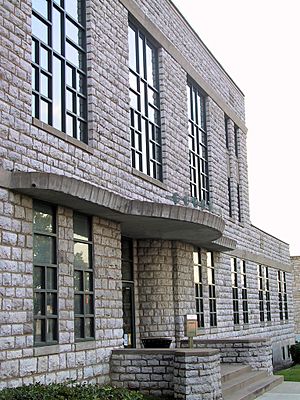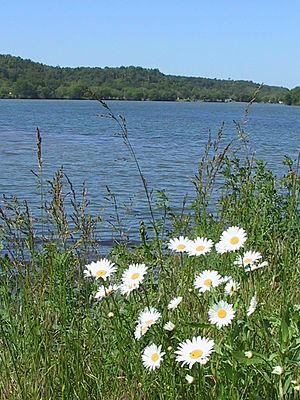Jay, Oklahoma facts for kids
Quick facts for kids
Jay, Oklahoma
|
|
|---|---|

Location of Jay, Oklahoma
|
|
| Country | United States |
| State | Oklahoma |
| County | Delaware |
| Area | |
| • Total | 3.33 sq mi (8.63 km2) |
| • Land | 3.33 sq mi (8.63 km2) |
| • Water | 0.00 sq mi (0.00 km2) |
| Elevation | 1,027 ft (313 m) |
| Population
(2020)
|
|
| • Total | 2,425 |
| • Density | 727.79/sq mi (281.00/km2) |
| Demonym(s) | Jayite |
| Time zone | UTC-6 (Central (CST)) |
| • Summer (DST) | UTC-5 (CDT) |
| ZIP code |
74346
|
| Area code(s) | 539/918 |
| FIPS code | 40-37650 |
| GNIS feature ID | 2410135 |
Jay is a city in the state of Oklahoma, United States. It is the main town, also known as the county seat, of Delaware County. In 2020, about 2,425 people lived in Jay.
A special thing about Jay is that almost 40% of its residents are Native American. Because of this, Jay is home to many offices for the Cherokee Nation tribe. It also has a health clinic for the Delaware District of the Cherokee Nation.
Jay is famous for being the "Huckleberry Capital of the World." Every year, usually around the Fourth of July, the city hosts a fun event called the Huckleberry Festival. This festival has been happening since 1967!
The city of Jay is run by a "council-manager" system. This means there's a city council that makes decisions, and a city manager who handles the daily operations. Becki Farley is the current mayor, and Kyle Stump is the Vice Mayor.
Contents
Jay's History
Jay got its name from a person named Jay Washbourne. He was related to Stand Watie, a famous Cherokee leader, and was the grandson of an early Cherokee missionary.
Jay became the county seat of Delaware County after a special election on December 8, 1908. Before that, Grove, Oklahoma held the title. Even though Grove tried to keep the county seat, the Oklahoma Supreme Court decided in favor of Jay on June 27, 1911. The official records were moved to Jay in January 1912.
Sadly, the courthouse in Jay burned down on May 10, 1913. This fire destroyed most of the county's important records. Jay officially became an incorporated city in 1939.
How Jay Was Planned
Most towns in Oklahoma from the late 1800s and early 1900s grew around rivers, major roads, or railway lines. But Jay is different! It was specifically planned and built to be a county seat.
Around 1908, a group called the Delaware County Improvement Association wanted to find the exact center of the county. They found a spot on land owned by Thomas Oochaleta, a full-blood Cherokee. However, it was hard to buy land from full-blood Cherokees because of federal rules.
So, the group looked at the land next to it, which belonged to Claude L. "Jay" Washbourne. Since he was a mixed-blood Cherokee, he could sell his land more easily. He gave ten acres of his land to build the new town.
The town was designed with a central block set aside for a courthouse. The committee quickly built a simple building and then asked the U.S. Postal Service for a post office. They suggested three names: "Center," "Jay," and "Washbourne." The postal service chose "Jay" because it was short and easy to remember.
Geography of Jay
Jay is located in a beautiful area of Oklahoma. It's part of the Ozark Plateau, which is known for its oak and hickory forests.
The United States Census Bureau says that Jay covers about 3.2 square miles (8.63 square kilometers) of land. There is no water area within the city limits. The Cherokee name for Jay is Dlaygvi, which means "Bluejay Place."
Jay is located where two important roads meet: U.S. Route 59 and Oklahoma State Highway 20. It's also southeast of Grand Lake of the Cherokees and northeast of Lake Eucha.
Jay's Population Facts
| Historical population | |||
|---|---|---|---|
| Census | Pop. | %± | |
| 1940 | 741 | — | |
| 1950 | 697 | −5.9% | |
| 1960 | 1,120 | 60.7% | |
| 1970 | 1,594 | 42.3% | |
| 1980 | 2,180 | 36.8% | |
| 1990 | 2,220 | 1.8% | |
| 2000 | 2,482 | 11.8% | |
| 2010 | 2,448 | −1.4% | |
| 2020 | 2,425 | −0.9% | |
| U.S. Decennial Census | |||
Let's look at some numbers about the people who live in Jay, based on the census from the year 2000:
- There were 2,482 people living in the city.
- These people lived in 954 households, and 609 of those were families.
- The city had about 767 people per square mile.
Who Lives in Jay?
The census also tells us about the different groups of people in Jay:
- About 54.43% of the people were White.
- About 36.50% were Native American.
- Smaller numbers of people were African American, Asian, or from other racial backgrounds.
- About 3.55% of the population identified as Hispanic or Latino.
Households and Families
- In 33.0% of the households, there were children under 18 years old.
- About 40.9% of households were married couples living together.
- About 17.8% of households had a female head of household with no husband present.
- About 32.6% of all households were made up of people living alone.
- The average household had 2.48 people, and the average family had 3.13 people.
Age and Income
- About 28.3% of the people were under 18 years old.
- About 15.5% were 65 years old or older.
- The average age in Jay was 34 years old.
- The median income for a household in Jay was $21,875 per year.
- The median income for a family was $25,592 per year.
- About 25.9% of the population lived below the poverty line. This included 35.1% of those under 18 and 22.3% of those 65 or older.
Famous People from Jay
Some notable people have come from Jay, Oklahoma:
- Linda Hughes O'Leary – A well-known Cherokee politician.
- Tommy Morrison – A former world heavyweight boxing champion.
- Ty Powell – A former NFL Linebacker for professional football teams.
- Buzz Wetzel – A baseball player.
- Jessy Grizzle – A robotics engineer.
See also
 In Spanish: Jay (Oklahoma) para niños
In Spanish: Jay (Oklahoma) para niños



